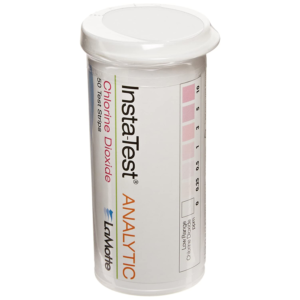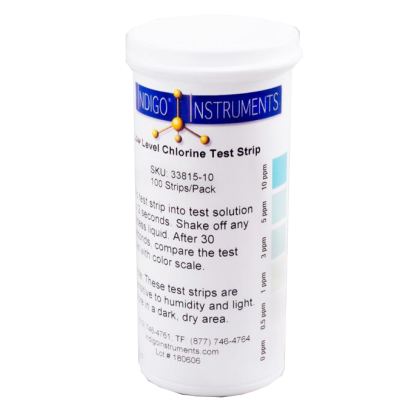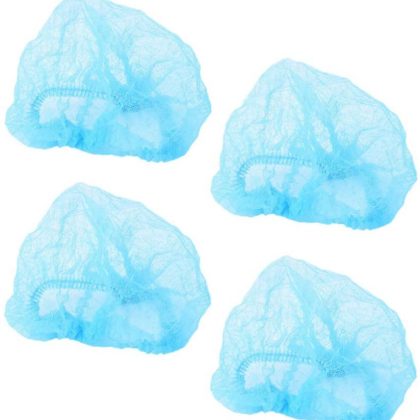- Exhalation valve keeps your face cool and dry
- M-Shape nose clip for better comfort and fit
-
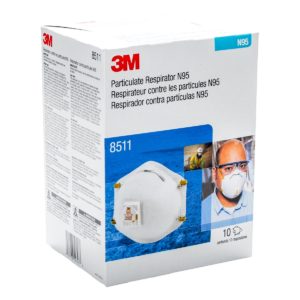 The 3M™ Particulate Respirator 8511 features a proprietary 3M™ Cool Flow™ Valve and helps provide comfortable, reliable respiratory protection. It is ideally suited for hot/dusty work settings that require long periods of wear.
The 3M™ Particulate Respirator 8511 features a proprietary 3M™ Cool Flow™ Valve and helps provide comfortable, reliable respiratory protection. It is ideally suited for hot/dusty work settings that require long periods of wear. -
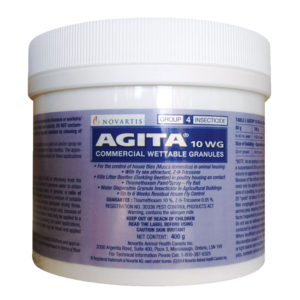 18 or more $44.99 each AGITA 10 WG is a new water dispersible residual insecticidal bait formulation for the control of house flies (Musca domestica) in agricultural buildings (e.g. barns, poultry houses, etc.). The novel combination of a neonicotinoid insecticide with both contact and stomach modes of action, with a house fly sex attractant and a bait, provides an effective fly bait formula which encourages both male and female house flies to remain in treated areas and consume or contact lethal doses of the product. This unique formulation affords the end user up to 6 weeks of residual activity when applied according to label directions. In addition, AGITA 10 WG kills litter beetles (Alphitobius diaperinus) on contact in broiler houses. AGITA 10 WG should be used as part of an integrated pest management program for insects. Directions for Use: General: Use any AGITA 10 WG suspension on the day of mixing, preferably immediately after preparation. Do not treat dirty, highly porous or newly whitewashed walls to prevent loss of long term efficacy. Do not apply on metal and glass surfaces to avoid excessive run-off. Treated surfaces may display a slight, discernible discolouration (white to beige film or powder) when dry, that permits applicators to identify treated surfaces and monitor the rate of bait consumption. Apply ONLY in locations not accessible to children, pets, domestic animals or wildlife, and ONLY on surfaces not routinely contacted by livestock or workers/bystanders. Protect from direct sunlight, water and rainfall. DO NOT contaminate irrigation or drinking water supplies or aquatic habitats by cleaning of equipment or disposal of wastes. AGITA 10 WG is a formulation suitable for application as a paint-on and/or spray-on insecticidal bait for house flies or a contact insecticide for litter beetles. The appropriate recommendations for use rates and individual methods for these applications are as follows: Paint-On for Adult Fly Control: Thoroughly mix the appropriate quantity of AGITA 10 WG to effectively treat the intended surface areas with a corresponding volume of lukewarm water to obtain a suspension with the consistency of a brushable paint. In general, a ratio of 125 grams of AGITA 10 WG per 100 mL of water produces a mixture of suitable consistency that effectively coats surfaces and provides adequate drying times. The freshly prepared suspension should be applied using a brush and, because of the highly attractive nature of the AGITA bait formulation, need only be applied to a small percentage of the available surface area of a building. For paint applications, a daily maximum quantity of 2.0 kg of AGITA 10 WG may be mixed and applied by one person. Because of the effective attractive nature of the AGITA formulation, the suspension need only be applied using a brush to a small percentage of the available surface area of a building. As a general guide, apply the suspension at a rate of approximately 20 “spots” (of about 10 x 30 cm each) per 100 m2 of ground surface, in areas where flies congregate, such as window sills, doors frames, warm wall areas and near animal pens, ensuring that the bait is kept out of reach of animals and away from surfaces frequented by humans and domestic pets. Stir occasionally during application. Do not use on walkways used by animals or on any surfaces that may be routinely contacted by workers or bystanders. Where insufficient surface area is available for painting or where some slight white discoloration caused by the “paint” is unacceptable, paint strips of cardboard, wood or light boards and hang them from the ceiling in locations not accessible to children, pets, domestic animals or wildlife. Spray-On for Adult Fly Control: For applications employing a low-pressure spray applicator, thoroughly mix the Fly Bait with lukewarm water at the ratio of 125 grams of AGITA 10 WG per 1000 mL of water to obtain a mixture of suitable consistency that will effectively coat surfaces while providing adequate drying times. Apply suspension using a standard course spray applicator to appropriate target locations of the wall/ceiling surface area. Again, because the effective attractive nature of the AGITA bait formulation, and unlike “traditional” agricultural fly wall sprays, the suspension need only be applied to a small percentage of the surface area of a building to provide effective fly control. The amount of diluted product required to treat a particular building will vary depending upon the nature of surface to be treated. Apply spray to the point of run-off, while avoiding excessive run-off, to areas where flies congregate, such as window sills/frames, door frames, warm wall areas and near animal pens, ensuring that the bait is kept out of reach of animals and away from surfaces frequented by humans and domestic pets. Stir occasionally during application. Do not use on walkways used by animals or on any surfaces that may be routinely contacted by workers or bystanders. Where insufficient surface area is available for bait application or where some slight discoloration caused by the spray is unacceptable, spray strips of cardboard, wood or light boards and hang them from the ceiling in locations not accessible to children, pets, domestic animals or wildlife. AGITA 10 WG may provide up to six weeks of residual activity, depending upon the size of the resident pest population, re-infestation or re-invasion from neighbouring farms, etc. Estimation of the amount of bait remaining can be determined by observation of the rate at which the slight discolouration of treated surfaces (slight whitish/beige “powder”) disappears. Re-apply the product, as necessary, so as to reduce the possibility of a resident fly population being re-established. The ultimate residual control afforded by AGITA 10 WG will depend upon the size and source of the resident fly population, the re-invasion rates from neighbouring agricultural practices, and the on-farm maintenance, sanitation and hygiene procedures and schedules (e.g. routine removal of fly breeding sites/material, etc.). It is always recommended that AGITA Fly Bait products be used as part of a complete integrated pest management program designed to minimize pest populations and optimize the housing conditions for economic animals. Directions for use against Litter Beetle in Broiler Houses (“Band Spray” Method): AGITA 10 WG kills litter beetles (Alphitobius diaperinus) by direct contact. Using the preparation methods detailed above, AGITA 10 WG should be applied as a suspension in a single 1m wide band at the rate of 4 grams per square metre of surface area (i.e. “band spray method” - ~ 2 to 3 X the house fly control rate). Ensure that the product is mixed with sufficient water to allow a thorough wetting of this 1m wide band on all sides of the broiler house (~1 L per 15 m2). The spray should be applied after cleaning of the facility and the placement of new litter, but just before the house is heated for the arrival of a new batch of chicks. The spray should be applied to the litter beetles’ primary migration routes towards the new litter. The area around any cracks or openings in the ceiling or walls should also be sprayed. The rationale for this program is the fact that the beetles hide in the ceiling or walls between cycles and then crawl out just before the new chicks arrive. At this point, therefore, they will come into contact with the spray band.
18 or more $44.99 each AGITA 10 WG is a new water dispersible residual insecticidal bait formulation for the control of house flies (Musca domestica) in agricultural buildings (e.g. barns, poultry houses, etc.). The novel combination of a neonicotinoid insecticide with both contact and stomach modes of action, with a house fly sex attractant and a bait, provides an effective fly bait formula which encourages both male and female house flies to remain in treated areas and consume or contact lethal doses of the product. This unique formulation affords the end user up to 6 weeks of residual activity when applied according to label directions. In addition, AGITA 10 WG kills litter beetles (Alphitobius diaperinus) on contact in broiler houses. AGITA 10 WG should be used as part of an integrated pest management program for insects. Directions for Use: General: Use any AGITA 10 WG suspension on the day of mixing, preferably immediately after preparation. Do not treat dirty, highly porous or newly whitewashed walls to prevent loss of long term efficacy. Do not apply on metal and glass surfaces to avoid excessive run-off. Treated surfaces may display a slight, discernible discolouration (white to beige film or powder) when dry, that permits applicators to identify treated surfaces and monitor the rate of bait consumption. Apply ONLY in locations not accessible to children, pets, domestic animals or wildlife, and ONLY on surfaces not routinely contacted by livestock or workers/bystanders. Protect from direct sunlight, water and rainfall. DO NOT contaminate irrigation or drinking water supplies or aquatic habitats by cleaning of equipment or disposal of wastes. AGITA 10 WG is a formulation suitable for application as a paint-on and/or spray-on insecticidal bait for house flies or a contact insecticide for litter beetles. The appropriate recommendations for use rates and individual methods for these applications are as follows: Paint-On for Adult Fly Control: Thoroughly mix the appropriate quantity of AGITA 10 WG to effectively treat the intended surface areas with a corresponding volume of lukewarm water to obtain a suspension with the consistency of a brushable paint. In general, a ratio of 125 grams of AGITA 10 WG per 100 mL of water produces a mixture of suitable consistency that effectively coats surfaces and provides adequate drying times. The freshly prepared suspension should be applied using a brush and, because of the highly attractive nature of the AGITA bait formulation, need only be applied to a small percentage of the available surface area of a building. For paint applications, a daily maximum quantity of 2.0 kg of AGITA 10 WG may be mixed and applied by one person. Because of the effective attractive nature of the AGITA formulation, the suspension need only be applied using a brush to a small percentage of the available surface area of a building. As a general guide, apply the suspension at a rate of approximately 20 “spots” (of about 10 x 30 cm each) per 100 m2 of ground surface, in areas where flies congregate, such as window sills, doors frames, warm wall areas and near animal pens, ensuring that the bait is kept out of reach of animals and away from surfaces frequented by humans and domestic pets. Stir occasionally during application. Do not use on walkways used by animals or on any surfaces that may be routinely contacted by workers or bystanders. Where insufficient surface area is available for painting or where some slight white discoloration caused by the “paint” is unacceptable, paint strips of cardboard, wood or light boards and hang them from the ceiling in locations not accessible to children, pets, domestic animals or wildlife. Spray-On for Adult Fly Control: For applications employing a low-pressure spray applicator, thoroughly mix the Fly Bait with lukewarm water at the ratio of 125 grams of AGITA 10 WG per 1000 mL of water to obtain a mixture of suitable consistency that will effectively coat surfaces while providing adequate drying times. Apply suspension using a standard course spray applicator to appropriate target locations of the wall/ceiling surface area. Again, because the effective attractive nature of the AGITA bait formulation, and unlike “traditional” agricultural fly wall sprays, the suspension need only be applied to a small percentage of the surface area of a building to provide effective fly control. The amount of diluted product required to treat a particular building will vary depending upon the nature of surface to be treated. Apply spray to the point of run-off, while avoiding excessive run-off, to areas where flies congregate, such as window sills/frames, door frames, warm wall areas and near animal pens, ensuring that the bait is kept out of reach of animals and away from surfaces frequented by humans and domestic pets. Stir occasionally during application. Do not use on walkways used by animals or on any surfaces that may be routinely contacted by workers or bystanders. Where insufficient surface area is available for bait application or where some slight discoloration caused by the spray is unacceptable, spray strips of cardboard, wood or light boards and hang them from the ceiling in locations not accessible to children, pets, domestic animals or wildlife. AGITA 10 WG may provide up to six weeks of residual activity, depending upon the size of the resident pest population, re-infestation or re-invasion from neighbouring farms, etc. Estimation of the amount of bait remaining can be determined by observation of the rate at which the slight discolouration of treated surfaces (slight whitish/beige “powder”) disappears. Re-apply the product, as necessary, so as to reduce the possibility of a resident fly population being re-established. The ultimate residual control afforded by AGITA 10 WG will depend upon the size and source of the resident fly population, the re-invasion rates from neighbouring agricultural practices, and the on-farm maintenance, sanitation and hygiene procedures and schedules (e.g. routine removal of fly breeding sites/material, etc.). It is always recommended that AGITA Fly Bait products be used as part of a complete integrated pest management program designed to minimize pest populations and optimize the housing conditions for economic animals. Directions for use against Litter Beetle in Broiler Houses (“Band Spray” Method): AGITA 10 WG kills litter beetles (Alphitobius diaperinus) by direct contact. Using the preparation methods detailed above, AGITA 10 WG should be applied as a suspension in a single 1m wide band at the rate of 4 grams per square metre of surface area (i.e. “band spray method” - ~ 2 to 3 X the house fly control rate). Ensure that the product is mixed with sufficient water to allow a thorough wetting of this 1m wide band on all sides of the broiler house (~1 L per 15 m2). The spray should be applied after cleaning of the facility and the placement of new litter, but just before the house is heated for the arrival of a new batch of chicks. The spray should be applied to the litter beetles’ primary migration routes towards the new litter. The area around any cracks or openings in the ceiling or walls should also be sprayed. The rationale for this program is the fact that the beetles hide in the ceiling or walls between cycles and then crawl out just before the new chicks arrive. At this point, therefore, they will come into contact with the spray band.Precautions
KEEP OUT OF REACH OF CHILDREN, PETS, DOMESTIC ANIMALS AND WILDLIFE. Avoid contact with skin, eyes and clothing. Avoid breathing spray mist. Wear coveralls over a long sleeved shirt and long pants, chemical-resistant gloves, shoes and socks when handling the product, clean-up and repair. Wear a NIOSH/MSHA-approved respirator when applying and a NIOSH/MSHA-approved dust-filtering mask during clean-up of the product that is not completely consumed. Wash exposed body parts and change clothing after handling, and before eating, drinking or smoking. Do not contaminate feed, water, food or litter through application or disposal of product. Do not apply bait where animals can lick the product. Prevent accidental transfer of the product, by people or animals, from treated areas to areas used by livestock. FIRST AID: IF SWALLOWED: Call a poison control centre or doctor immediately for treatment advice. Do not induce vomiting unless told to do so by a poison control centre or doctor. Do not give any liquid to the person. Do not give anything by mouth to an unconscious person. IF ON SKIN OR CLOTHING: Take off contaminated clothing. Rinse skin immediately with plenty of water for 15-20 minutes. Call a poison control centre or doctor for treatment advice. IF INHALED: Move person to fresh air. If person is not breathing, call 911 or an ambulance, then give artificial respiration, preferably by mouth-to-mouth, if possible. Call a poison control centre or doctor for further treatment advice. IF IN EYES: Hold eye open and rinse slowly and gently with water for 15-20 minutes. Remove contact lenses, if present, after the first 5 minutes, then continue rinsing eye. Call a poison control centre or doctor for treatment advice. Take container, label or product name and Pest Control Product Registration Number with you when seeking medical attention. TOXICOLOGICAL INFORMATION: There is no specific antidote for this product if ingested. If a large amount has been ingested and emesis is inadequate, lavage stomach. Treat symptomatically. ENVIRONMENTAL HAZARD: Toxic to bees. RESISTANCE MANAGEMENT: For resistance management, thiamethoxam is a Group 4 insecticide. Any house fly population may contain individuals naturally resistant to thiamethoxam and Group 4 insecticides. To delay insecticide resistance, avoid exclusive, repeated use of AGITA Fly Bait or other Group 4 insecticides. Keep accurate records of insecticides used in your operation. Keep the house fly population as low as possible by manure management.Storage
Store product in original, tightly sealed container. Store in a cool, dry place. Do not contaminate water, food or feed by storage or disposal. Do not reuse empty container.Disposal
1. Triple-or-pressure-rinse the empty container. Add the rinsings to the spray mixture in the tank. 2. Follow provincial instruction for any required additional cleaning of the container prior to its disposal. 3. Make the empty container unsuitable for further use. 4. Dispose of the container in accordance with provincial requirements. 5. For information on disposal of unused, unwanted product, contact the manufacturer or the provincial regulatory agency. Contact the manufacturer and the provincial regulatory agency in case of a spill, and for clean-up of spills. MSDS -
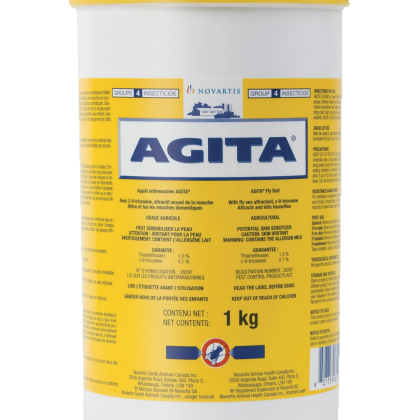 AGITA Fly Bait is a new fly bait formula containing a house fly sex attractant which encourages both male and female house flies to remain in the treated areas, thereby feeding on the bait. Bait should be scattered once per day over fly feeding areas and places where flies are known to congregate to provide initial knockdown and reduction of house fly populations. Scatter AGITA Fly Bait at a rate of 200 g per 100 m2 from a container or other device to avoid handling bait. Bait may also be used in hanging or stationary tamper-resistant bait boxes in locations not accessible to children, pets, domestic animals or wildlife. AGITA Fly Bait should be used as part of an integrated pest management program for house flies. AREAS OF USE: May be used in agricultural buildings (e.g. barns, poultry houses, etc.) in areas where house flies congregate such as windowsills and near animal pens, provided the bait is kept out of reach of animals. Do not use on walkways used by animals.
AGITA Fly Bait is a new fly bait formula containing a house fly sex attractant which encourages both male and female house flies to remain in the treated areas, thereby feeding on the bait. Bait should be scattered once per day over fly feeding areas and places where flies are known to congregate to provide initial knockdown and reduction of house fly populations. Scatter AGITA Fly Bait at a rate of 200 g per 100 m2 from a container or other device to avoid handling bait. Bait may also be used in hanging or stationary tamper-resistant bait boxes in locations not accessible to children, pets, domestic animals or wildlife. AGITA Fly Bait should be used as part of an integrated pest management program for house flies. AREAS OF USE: May be used in agricultural buildings (e.g. barns, poultry houses, etc.) in areas where house flies congregate such as windowsills and near animal pens, provided the bait is kept out of reach of animals. Do not use on walkways used by animals.Precautions
KEEP OUT OF REACH OF CHILDREN, PETS, DOMESTIC ANIMALS AND WILDLIFE. Do not ingest or inhale. Avoid contact with skin, eyes and clothing. Wear coveralls over a long-sleeved shirt and long pants, chemical-resistant gloves, shoes and socks when handling the product.Wear a NIOSH/MSHA-approved dust-filtering mask, long- sleeved shirt, long pants, shoes and socks during the clean up of product which is not completely consumed. Wash exposed body parts and change clothing after handling, and before eating, drinking or smoking. Do not contaminate feed, water, food or litter through application or disposal of product. Do not apply bait where animals can pick it up or lick the product. Prevent accidental transfer of the product, by people or animals, from treated areas to areas used by livestock. Harmful to bees. Do not discharge leftover product into ponds, streams or sewage systems. FIRST AID: If on skin or clothing: Take off contaminated clothing. Rinse skin immediately with plenty of water for 15-20 minutes. Call a poison control centre or doctor for treatment advice. If in eyes: Hold eye open and rinse slowly and gently with water for 15-20 minutes. Remove contact lenses, if present, after the first 5 minutes, then continue rinsing eye. Call a poison control centre or doctor for treatment advice. If swallowed: Call a poison control centre or doctor immediately for treatment advice. Have person sip a glass of water if able to swallow. Do not induce vomiting unless told to do so by a poison control centre or doctor. Do not give anything by mouth to an unconscious person. If inhaled: Move person to fresh air. If person is not breathing, call 911 or an ambulance, then give artificial respiration, preferably by mouth- to-mouth, if possible. Call a poison control centre or doctor for further treatment advice. Take container, label or product name and Pest Control Product Registration Number with you when seeking medical attention. TOXICOLOGICAL INFORMATION: No specific antidote is known. Apply symptomatic therapy. Induce emesis or lavage stomach. STORAGE AND DISPOSAL: Store in original, tightly closed containers. Protect from light and humidity. Do not contaminate water, food or feed by storage or disposal. Do not discharge leftover product into ponds, streams or sewage systems. Do not reuse empty container. Dispose of unused or spoiled bait in accordance with local requirements. Follow provincial instructions for any required cleaning of the container prior to its disposal. Make the empty container unsuitable for further use. Dispose of the container in accordance with provincial requirements. For information on disposal of unused, unwanted product, contact the manufacturer or the provincial regulatory agency. Contact the manufacturer and the provincial regulatory agency in case of a spill, and for the clean-up of spills. MSDS -
 Hydrion Ammonia Test Strips provide a simple and economical means of measuring the ammonia concentration in the environment. These test strips are compliant with local animal welfare programs. Simply wet the strip with some water and wave it in the air. After 10-15 seconds compare the colour of the strip against the colour of the chart.
Hydrion Ammonia Test Strips provide a simple and economical means of measuring the ammonia concentration in the environment. These test strips are compliant with local animal welfare programs. Simply wet the strip with some water and wave it in the air. After 10-15 seconds compare the colour of the strip against the colour of the chart. -
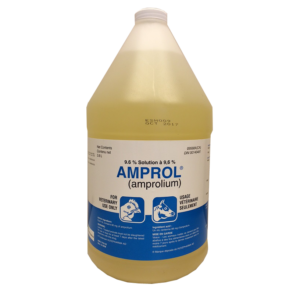 4 or more: $130.99 each This treatment applies to the following species: -Beef Cattle, Chickens, Dairy Cattle DIN 00140481 Veterinary Use Only Active Ingredient: Each mL contains 96 mg of amprolium
4 or more: $130.99 each This treatment applies to the following species: -Beef Cattle, Chickens, Dairy Cattle DIN 00140481 Veterinary Use Only Active Ingredient: Each mL contains 96 mg of amproliumAmprol 9.6% Solution Indications
POULTRY - As an aid in the treatment of caecal coccidiosis in growing chickens and laying birds. CALVES - As an aid in the treatment of coccidiosis caused by Eimeria bovis and E. zuernii in calves.Use Directions
POULTRY - As soon as caecal coccidiosis is diagnosed, give 0.024% amprolium in the drinking water for 5 to 7 days. Continue the treatment with 0.006% amprolium medicated water for an additional one to two weeks. No other source of drinking water should be available to the birds during this time. Use as the sole source of amprolium. CALVES - 0.012% amprolium in drinking water for 5 days. At the usual rate of water consumption, this will provide a daily intake of approximately 10 mg of amprolium per kg of body weight. Give as the sole source of water during the treatment period. NOTE - When one or more calves show signs of coccidiosis, it is likely that the rest of the group have been exposed, and all calves in the group should be treated. MIXING DIRECTIONS: To prepare 200 L of medicated water:DOSAGE MIXING DIRECTIONS 0.0240% Add 500 mL of AMPROL® 9.6% Solution to about 25 L of water in a 200 L medication barrel. Stir, then add water to the 200 L mark. STIR THOROUGHLY. 0.0120% Use same directions as above but use 250 mL of AMPROL® 9.6% Solution. 0.0060% Use same directions as above but use 125 mL of AMPROL® 9.6% Solution. Warnings
Calves - Treated animals must not be slaughtered for use in food for at least 7 days after the latest treatment with this drug.Cautions:
1. POULTRY - If no improvement is noted within 3 days, have the diagnosis reconfirmed and follow the instructions of your veterinarian or poultry pathologist. Losses may result from intercurrent disease or other conditions affecting drug intake which can contribute to the virulence of coccidiosis under field conditions. 2. CALVES - For a satisfactory diagnosis, a microscopic examination of the feces should be done before treatment. When treating outbreaks, drug should be administered promptly after diagnosis is determined. Do not use in calves intended for future breeding.Storage
Protect from freezing. Keep above 5°C. -
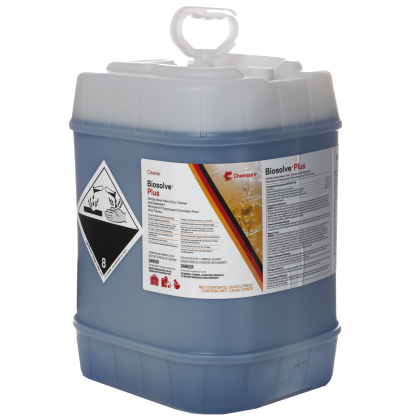 For the removal of organic soiling especially fats and greases. Biosolve™ Plus is ideal for the removal of fecal matter and soiling on swine, poultry, turkey farms, in the hatchery and animal confinement facilities. Biosolve™ PLUS will remove stubborn fats and grease from all processing equipment such as conveyor belts, separator machines, shackles and cutting blades.
For the removal of organic soiling especially fats and greases. Biosolve™ Plus is ideal for the removal of fecal matter and soiling on swine, poultry, turkey farms, in the hatchery and animal confinement facilities. Biosolve™ PLUS will remove stubborn fats and grease from all processing equipment such as conveyor belts, separator machines, shackles and cutting blades.Directions For Use
Low or High Pressure Spraying: Prepare a stock solution of Biosolve™ PLUS 2-24 mL/liter (0.25-3.0 ounces per gallon), or calibrate your dosing equipment to achieve this dilution. Spray the solution onto all surfaces at an application rate of 500 mL/m2 (1.6 oz/ft2). Using hot water (60-65°C/140-149°F) will improve the effectiveness of the product, particularly in high grease situations. Allow contact time of 5-10 minutes before thoroughly rinsing all surfaces with clean water at high pressure. Foaming: Prepare a 8-24 mL/liter (1-3 ounces per gallon) stock solution of Biosolve™ PLUS, or calibrate your dosing equipment to achieve this dilution. Apply using a foam lance onto all surfaces at an application rate of 250 mL/m2 (0.8 oz/ft2). Allow a contact time of 5-10 minutes before thoroughly rinsing all surfaces with clean water at high pressure. Food & Egg Processing Equipment, Utensils and Other Food Contact Surfaces: Follow foam cleaning instructions. Thoroughly rinse cleaned surfaces with potable water before they are reused. Where recommended or permitted, apply a sanitizer solution to food contact surfaces before reuse. Recommended Dilution Rates ● Heavy soiling: 16 - 24 mL / L (2.0 - 3.0 ounces per gallon) ● Medium soiling: 8 - 16 mL / L (1.0 - 2.0 ounces per gallon) ● Light soiling: 2.0 - 8.0 mL / L (0.25 - 1.0 ounce per gallon)Storage And Disposal
Store in original container, in areas inaccessible to children. Keep container tightly closed. Do not store on side. Avoid creasing or impacting of side walls. Do not reuse empty container. Discard in trash or recycle. MSDS -
Out of stock
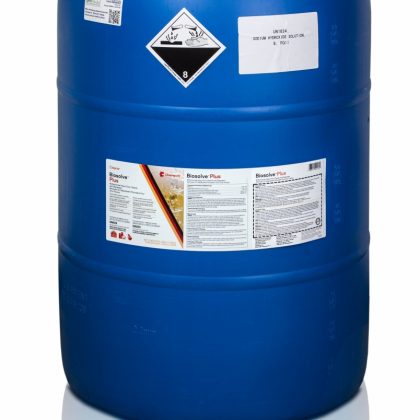 Call for price For the removal of organic soiling especially fats and greases. Biosolve™ Plus is ideal for the removal of fecal matter and soiling on swine, poultry, turkey farms, in the hatchery and animal confinement facilities. Biosolve™ PLUS will remove stubborn fats and grease from all processing equipment such as conveyor belts, separator machines, shackles and cutting blades.
Call for price For the removal of organic soiling especially fats and greases. Biosolve™ Plus is ideal for the removal of fecal matter and soiling on swine, poultry, turkey farms, in the hatchery and animal confinement facilities. Biosolve™ PLUS will remove stubborn fats and grease from all processing equipment such as conveyor belts, separator machines, shackles and cutting blades.Directions For Use
Low or High Pressure Spraying: Prepare a stock solution of Biosolve™ PLUS 2-24 mL/liter (0.25-3.0 ounces per gallon), or calibrate your dosing equipment to achieve this dilution. Spray the solution onto all surfaces at an application rate of 500 mL/m2 (1.6 oz/ft2). Using hot water (60-65°C/140-149°F) will improve the effectiveness of the product, particularly in high grease situations. Allow contact time of 5-10 minutes before thoroughly rinsing all surfaces with clean water at high pressure. Foaming: Prepare a 8-24 mL/liter (1-3 ounces per gallon) stock solution of Biosolve™ PLUS, or calibrate your dosing equipment to achieve this dilution. Apply using a foam lance onto all surfaces at an application rate of 250 mL/m2 (0.8 oz/ft2). Allow a contact time of 5-10 minutes before thoroughly rinsing all surfaces with clean water at high pressure. Food & Egg Processing Equipment, Utensils and Other Food Contact Surfaces: Follow foam cleaning instructions. Thoroughly rinse cleaned surfaces with potable water before they are reused. Where recommended or permitted, apply a sanitizer solution to food contact surfaces before reuse. Recommended Dilution Rates ● Heavy soiling: 16 - 24 mL / L (2.0 - 3.0 ounces per gallon) ● Medium soiling: 8 - 16 mL / L (1.0 - 2.0 ounces per gallon) ● Light soiling: 2.0 - 8.0 mL / L (0.25 - 1.0 ounce per gallon)Storage And Disposal
Store in original container, in areas inaccessible to children. Keep container tightly closed. Do not store on side. Avoid creasing or impacting of side walls. Do not reuse empty container. Discard in trash or recycle. MSDS -
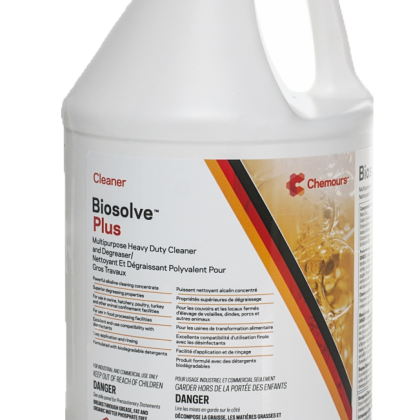 For the removal of organic soiling especially fats and greases. Biosolve™ Plus is ideal for the removal of fecal matter and soiling on swine, poultry, turkey farms, in the hatchery and animal confinement facilities. Biosolve™ PLUS will remove stubborn fats and grease from all processing equipment such as conveyor belts, separator machines, shackles and cutting blades.
For the removal of organic soiling especially fats and greases. Biosolve™ Plus is ideal for the removal of fecal matter and soiling on swine, poultry, turkey farms, in the hatchery and animal confinement facilities. Biosolve™ PLUS will remove stubborn fats and grease from all processing equipment such as conveyor belts, separator machines, shackles and cutting blades.Directions For Use
Low or High Pressure Spraying: Prepare a stock solution of Biosolve™ PLUS 2-24 mL/liter (0.25-3.0 ounces per gallon), or calibrate your dosing equipment to achieve this dilution. Spray the solution onto all surfaces at an application rate of 500 mL/m2 (1.6 oz/ft2). Using hot water (60-65°C/140-149°F) will improve the effectiveness of the product, particularly in high grease situations. Allow contact time of 5-10 minutes before thoroughly rinsing all surfaces with clean water at high pressure. Foaming: Prepare a 8-24 mL/liter (1-3 ounces per gallon) stock solution of Biosolve™ PLUS, or calibrate your dosing equipment to achieve this dilution. Apply using a foam lance onto all surfaces at an application rate of 250 mL/m2 (0.8 oz/ft2). Allow a contact time of 5-10 minutes before thoroughly rinsing all surfaces with clean water at high pressure. Food & Egg Processing Equipment, Utensils and Other Food Contact Surfaces: Follow foam cleaning instructions. Thoroughly rinse cleaned surfaces with potable water before they are reused. Where recommended or permitted, apply a sanitizer solution to food contact surfaces before reuse. Recommended Dilution Rates ● Heavy soiling: 16 - 24 mL / L (2.0 - 3.0 ounces per gallon) ● Medium soiling: 8 - 16 mL / L (1.0 - 2.0 ounces per gallon) ● Light soiling: 2.0 - 8.0 mL / L (0.25 - 1.0 ounce per gallon)Storage And Disposal
Store in original container, in areas inaccessible to children. Keep container tightly closed. Do not store on side. Avoid creasing or impacting of side walls. Do not reuse empty container. Discard in trash or recycle. MSDS -
 Credo is a premise spray for the control of darkling beetles (lesser meal worms) in poultry facilities.Credo MSDS
Credo is a premise spray for the control of darkling beetles (lesser meal worms) in poultry facilities.Credo MSDSGUARANTEE: Imidacloprid 526g/L Directions For Use:
Mix 90 mL in 2 – 7.5 L of water per 100m2. Use sufficient water to obtain a mixture that will provide effective coverage of surfaces but not require excessive drying time. Apply after clean out and before new birds are introduced to the house. Treat all areas where beetles are located, such as under feed/water lines, the lower section of walls, support beams and in cracks and crevices. The level of infestation will determine whether using a band application or treating the whole poultry house is required. Always read and follow complete instructions on the product label before use. Do not apply when birds are present. Apply between flocks following de-caking/sanitation. DO NOT enter or allow worker entry into treated areas until sprays have dried. Allow treated surfaces to dry before restocking/reintroducing birds into the facility. Refer to label for complete list of instructions.Environmental Hazards
This product is highly toxic to aquatic invertebrates. Keep out of lakes, streams, ponds or other aquatic systems. Do not contaminate water when disposing of equipment wash waters. This product is highly toxic to bees exposed to direct treatment or residues on blooming crops or weeds. Do not apply this product or allow it to drift to blooming crops or weeds if bees are visiting the treatment area. This product is toxic to birds. Apply this product only in accordance with the label.First Aid
Take the container, label or product name and Pest Control Product Registration Number with you when seeking medical attention. IF SWALLOWED: Call a poison control centre or doctor immediately for treatment advice. Have person sip a glass of water if able to swallow. Do not induce vomiting unless told to do so by the poison control centre or doctor. Do not give anything by mouth to an unconscious person. IF IN EYES: Hold eye open and rinse slowly and gently with water for 15-20 minutes. Remove contact lenses, if present, after the first 5 minutes, then continue rinsing eye. Call a poison control centre or doctor for treatment advice. IF ON SKIN OR CLOTHING: Take off contaminated clothing. Rinse skin immediately with plenty of soap and water for 15-20 minutes. Call a poison control centre or doctor for treatment advice. IF INHALED: Move person to fresh air. If person is not breathing, call 911 or an ambulance, then give artificial respiration, preferably by mouth to mouth if possible. Call a poison control centre or doctor for treatment advice. TOXICOLOGICAL INFORMATION: No specific antidote is available. Treat symptomatically.Storage And Disposal
Store in a cool, dry place and in such a manner as to prevent cross contamination with other pesticides, fertilizers, food, and feed. Store in original container and out of the reach of children, preferably in a locked storage area. Do not contaminate water, food or feed by storage or disposal. Store in a cool, dry secured storage area. Do not store this product under wet conditions. For information on disposal of unused, unwanted product, contact the manufacturer or the provincial regulatory agency. Contact the manufacturer and the provincial regulatory agency in case of a spill, and for clean-up of spills. -
 For control of the lesser mealworm (the darkling beetles Alphitobius diaperinus) and other listed pests ACTIVE INGREDIENT: Tetrachlorvinphos - 50% w/w In case of spills, poisoning or fire, call your provincial emergency response line.
For control of the lesser mealworm (the darkling beetles Alphitobius diaperinus) and other listed pests ACTIVE INGREDIENT: Tetrachlorvinphos - 50% w/w In case of spills, poisoning or fire, call your provincial emergency response line.DIRECTIONS FOR USE
Use Debantic 50WP as part of an overall integrated pest management (IPM) program. Debantic 50WP Insecticide Poultry and Livestock Premise Spray is suitable for use in conventional power or low pressure knapsack sprayers. Agitation is recommended to prevent undue settling of the suspension. Follow the USE DIRECTIONS for the proper percent solution needed for a specific insect and areas or types of wall surfaces. Refer to DILUTION TABLE for the quantity of insecticide needed to make the percent solution recommended. PREMISES USE DIRECTIONSPOULTRY USE DIRECTIONS (DO NOT APPLY TO RESIDENCES)INSECT PROBLEM AREAS % SOLUTION REMARKS Flies Dairy barns, poultry houses, swine barns, other animal buildings. 2.0% For dry whitewashed wood or concrete block surfaces, apply 8 litres of solution/100 sq. m. 1.0% For unpainted wood or painted concrete block surfaces, apply 8 litres of solution/100 sq. m. 1.0% For masonite or galvanized sheet metal surfaces, apply 4 litres of solution/100 sq. m. Maggots Poultry droppings, manure piles, garbage piles, under feed troughs 1.0% Apply 4 litres of solution/10 sq. m. Penetrate problem area first time - repeat every 7-10 days thereafter. DILUTION TABLEINSECT TYPE OF HOUSING % SOLUTION REMARKS Lice & Mites Wire Cages 0.5% Apply directly to birds (4 litres/100 birds). Spray vent and fluff areas from below. Repeat when necessary. Do not repeat more often than every 14 days. For individual bird treatment, apply 30 mL of the mixture per bird. NOTE: For maximum lasting control of the northern fowl mite, penetration of the feathers around the vent area is essential. Use power sprayer at 7-9 kg/sq cm at no less than recommended pressure. More attention must be given to each individual bird when using low-pressure equipment. Treat roosters carefully and thoroughly to avoid re-infestation in breeding flocks. Floor Management Dust Box 50% WP Mix evenly throughout top layer of box contents using 150 g/100 birds. Lice, Mite & Larvae and adults of the lesser mealworm (the darkling beetle, Alphitobius diaperinus) Floor Management Roost Paint 1.0% Treat with brush or spray thoroughly, particularly cracks and crevices using 145-165 mL/10 m. Floor Management Litter 1.0% Apply 1-4 litres/100 sq. m. evenly for penetration to litter surface. Also apply thoroughly to walls, roost, cracks, crevices and interiors. Spray birds lightly. Floor Management Litter 50% WP Treat evenly and thoroughly using 75 g/10 sq. m. Use a rotary or mechanical duster. (Wear dust mask during this operation). Fowl Tick All Types 1.0% Apply 3-4 litres/10 sq. m. thoroughly to walls, ceilings, floor cracks and crevices with a power sprayer. PRECAUTIONS KEEP OUT OF REACH OF CHILDREN AND LIVESTOCK. Harmful if swallowed or absorbed through skin. Avoid breathing spray mist and dust. Do not get in eyes, on skin, or on clothing. Wash thoroughly with soap and water after handling and before eating or smoking. Avoid contamination of feed and foodstuffs. Store apart from food and feed in a cool place. This product is toxic to fish. Do not contaminate water by disposal of this product. Do not re-use empty container. FIRST AID IF SWALLOWED: Call a poison control centre or doctor immediately for treatment advice. Have person sip a glass of water if able to swallow. Do not induce vomiting unless told to do so by a poison control centre or doctor. Do not give anything by mouth to an unconscious person. IF INHALED: Move person to fresh air. If person is not breathing, call 911 or an ambulance, then give artificial respiration, preferably by mouth-to-mouth, if possible. Call a poison control centre or doctor for further treatment advice. IF ON SKIN OR CLOTHING: Take off contaminated clothing. Rinse skin immediately with plenty of water for 15-20 minutes. Call a poison control centre or doctor for treatment advice. IF IN EYES: Hold eye open and rinse slowly and gently with water for 15-20 minutes. Remove contact lenses if present, after the first 5 minutes, then continue rinsing eye. Call a poison control centre or doctor for treatment advice. Take container, label or product name and Pest Control Product Registration Number with you when seeking medical attention. TOXICOLOGICAL INFORMATION Tetrachlorvinphos is a cholinesterase inhibitor. Typical symptoms of overexposure to cholinesterase inhibitors include headache, nausea, dizziness, sweating, salivation, runny nose and eyes. This may progress to muscle twitching, weakness, tremor, incoordination, vomiting, abdominal cramps and diarrhea in more serious poisonings. A life-threatening poisoning is signified by loss of consciousness, incontinence, convulsions and respiratory depression with a secondary cardiovascular component. Treat symptomatically. If exposed, plasma and red blood cell cholinesterase tests may indicate degree of exposure (baseline data are useful). Atropine, only by injection, is the preferable antidote. Oximes, such as Pralidoxime Chloride, may be therapeutic if used early; however, use only in conjunction with atropine. In cases of severe acute poisoning, use antidotes immediately after establishing an open airway and respiration. With oral exposure, the decision of whether to induce vomiting or not should be made by an attending physician. DISPOSAL 1. Triple-or pressure-rinse the empty container. Add the rinsings to the spray mixture in the tank. 2. Follow provincial instruction for any required additional cleaning of the container prior to its disposal. 3. Make the empty container unsuitable for further use. 4. Dispose of the container in accordance with provincial requirements. 5. For information on disposal of unused, unwanted product, contact the manufacturer or the provincial regulatory agency. Contact the manufacturer and the provincial regulatory agency in case of a spill and for clean-up of spills. MSDSAMOUNT (kg) OF 50% WETTABLE POWDER AMOUNT OF WATER 0.5% SOLUTION 1% SOLUTION 2% SOLUTION 1/4 kg 25 litres 12 1/2 litres 6 1/4 litres 1 100 litres 50 litres 25 litres 2 200 litres 100 litres 50 litres 4 400 litres 200 litres 100 litres -
 A water soluble multi-vitamin and electrolyte mixture for chickens, turkeys, swine, cattle, sheep and horses. This treatment applies to the following species: -Beef Cattle, Chickens, Dairy Cattle, Horses, Sheep, Swine, Turkeys DIN 02122022 Active Ingredients (per 400g)
A water soluble multi-vitamin and electrolyte mixture for chickens, turkeys, swine, cattle, sheep and horses. This treatment applies to the following species: -Beef Cattle, Chickens, Dairy Cattle, Horses, Sheep, Swine, Turkeys DIN 02122022 Active Ingredients (per 400g)Vitamin A (Vitamin A acetate) 1 280 000 I.U. Vitamin D3 (Cholecalciferol) 1 000 000 I.U. Vitamin E (Dl-alpha-tocopheryl acetate) 1 500 I.U. Vitamin B12 2560 mcg Folic acid 150 mg Menadione (Menadione sodium bisulfite) 500 mg Calcium-d-pantothenate 3200 mg Niacinamide 6720 mg Riboflavin 1280 mg Choline bitartrate 5760 mg Sodium chloride 277.71 g Sodium acetate 35.71 g Sodium diacetate 7.14 g (Total sodium eq. 120.58 g) Potassium chloride (Potassium eq. 7.48 g) 14.28 g Magnesium chloride (Magnesium eq. 1.82 g) 7.14 g Calcium acetate (Calcium eq. 1.81 g) 7.14 g Directions for Use
Chickens, turkeys, swine, cattle, sheep and horses: - As an aid in stimulating appetite during periods of stress caused by disease, moving, crowding, vaccination, castration or weather. - As an aid in preventing vitamin deficiencies when birds or animals are off normal feed. - As an aid in correcting dehydration and electrolyte imbalance during periods of severe stress, scouring or other enteric diseases that may cause dehydration. - As an aid in recovering from the stress effects of parasites, such as coccidia or intestinal worms. DOSAGE (In drinking water): Chickens, turkeys, swine, cattle, sheep and horses: Dissolve 400 g (1 pouch) of powder in 750 L of drinking water. Treat for 5 days or until feed consumption returns to normal and the effects of dehydration disappear. For automatic proportioner: Set the apparatus to distribute 30 mL per 4 L of water (1 oz./gallon U.S.). Prepare the stock solution by dissolving 400 g (1 pouch) of powder in 5.6 L of water. This will medicate 750 L of drinking water. For continuous low level supplementation of normal diet: Dissolve 400 g (1 pouch) of powder in 2250 L of drinking water. For automatic proportioner: Set the apparatus to distribute 30 mL per 4 L of drinking water (1 oz./gallon U.S.). Prepare the stock solution by dissolving 400 g (1 pouch) of powder in 17 L of water. This will medicate 2250 L of drinking water.Storage
Store between 15°C and 25°C. Protect from moisture. Keep hermetically closed when not used. Keep pail tightly closed when not used.Notes
Prepare fresh solutions daily and mix only the amount that will be consumed in a 24-hour period. Use as the only source of drinking water. 1 teaspoonful equals 5 g. The measuring cup contained herein (10 kg), when filled with a level quantity provides approximately 200 g of product. Net Weight 10kg pail -
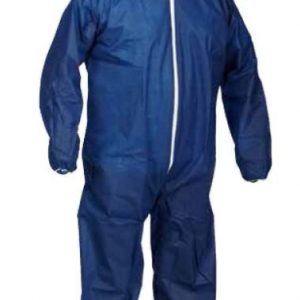 The Polypropylene Disposable Coverall with Hood is a 100% polypropylene, hooded garment featuring a zip front and elastic at the wrist, ankle, and hood. It is an extremely lightweight, and breathable option, perfect for protection against dirt, grease, and grime in non-hazardous settings.
The Polypropylene Disposable Coverall with Hood is a 100% polypropylene, hooded garment featuring a zip front and elastic at the wrist, ankle, and hood. It is an extremely lightweight, and breathable option, perfect for protection against dirt, grease, and grime in non-hazardous settings.- 100% Polypropylene
- Hooded
- Zip front
- Elastic at wrist, ankle and hood
- Low-cost disposable garment that protects from dirt, grease and grime. Extremely lightweight and breathable. Ideal for non- hazardous work environments
- Available in Navy Blue
- Available in Large, XL, XXL, XXXL
-
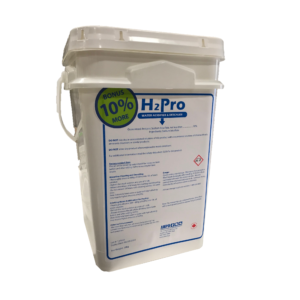 H2Pro is a granular inorganic acid with the purpose of acidifying livestock drinking water and descaling drinking water systems. Composed of a singly inorganic acid, H2Pro is very economical compared to other acidifiers. The pH of the drinking water should be measured both before and after adding H2Pro to accomplish best results. Waterline Cleaning and Descaling: -Thoroughly dissolve 600g of H2Pro into 10L of stock solution. -Deliver the stock solution at a rate of 1:128. -Allow a minimum of 8 hours for cleaning and descaling. -Do not exceed 24 hours with cleaning solution in water lines. Note: Extremely hard water or water with high alkalinity may require higher amounts of H2Pro. Drinking Water Acidification for Poultry: -Thoroughly dissolve 300 - 600g of H2Pro into 10L of stock solution. -Deliver the stock solution at a rate of 1:128. -Always measure the pH of the drinking water both before and after adding H2Pro. Note: Extremely hard water or water with high alkalinity may require higher amounts of H2Pro. Chlorine Enhancement: -Maintain final solution pH levels between 6 & 7 to achieve the best results when using chlorine for disinfectant purposes. *Pallet Pricing Available, Please Call for Details* *Pricing is Subject to Change*
H2Pro is a granular inorganic acid with the purpose of acidifying livestock drinking water and descaling drinking water systems. Composed of a singly inorganic acid, H2Pro is very economical compared to other acidifiers. The pH of the drinking water should be measured both before and after adding H2Pro to accomplish best results. Waterline Cleaning and Descaling: -Thoroughly dissolve 600g of H2Pro into 10L of stock solution. -Deliver the stock solution at a rate of 1:128. -Allow a minimum of 8 hours for cleaning and descaling. -Do not exceed 24 hours with cleaning solution in water lines. Note: Extremely hard water or water with high alkalinity may require higher amounts of H2Pro. Drinking Water Acidification for Poultry: -Thoroughly dissolve 300 - 600g of H2Pro into 10L of stock solution. -Deliver the stock solution at a rate of 1:128. -Always measure the pH of the drinking water both before and after adding H2Pro. Note: Extremely hard water or water with high alkalinity may require higher amounts of H2Pro. Chlorine Enhancement: -Maintain final solution pH levels between 6 & 7 to achieve the best results when using chlorine for disinfectant purposes. *Pallet Pricing Available, Please Call for Details* *Pricing is Subject to Change*

